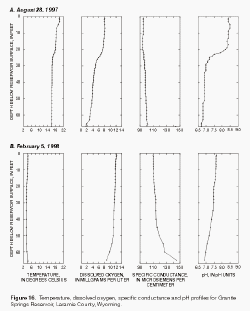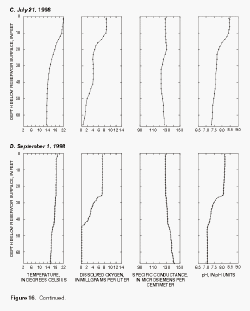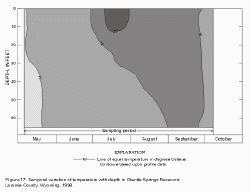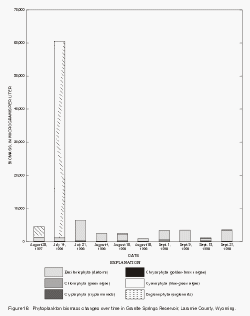
Granite Springs Reservoir
Granite Springs Reservoir is the third reservoir in the series (fig.
2C) and
receives water through both Stage I and Stage II pipelines from Lake Owen. The
reservoir contains about 12 percent of the system storage and has a spillway
elevation of 7,210 ft above sea level (table 1). Granite Springs is located in
an area of mixed forest and grassland. It is an active recreational site with
boating, fishing, and camping being the primary activities. Some houses are
present in the area surrounding the reservoir.
Profile data were collected for Granite Springs once during summer 1997, from
mid-May through the first part of October in 1998, and once during winter 1998.
These profiles indicate that Granite Springs was stratified by early to mid-July
and was unstratified in the winter.
The August 28, 1997 profiles (fig. 16A) indicate stratification in the
reservoir. Changes in the temperature, dissolved oxygen, specific conductance,
and pH profiles indicate that the epilimnion extended from the surface to about
19 ft deep. In the epilimnion, the temperature decreased from 20 to 18°C,
dissolved-oxygen concentrations were about 7 to 8 mg/L, specific conductance was
about 94 to 95 µS/cm, and pH ranged from 8.3 to 8.5. Dissolved-oxygen
concentrations in the epilimnion were above saturation, probably due to
photosynthetic activity by the phytoplankton. The euphotic zone also extended to
about 19 ft, as estimated from a Secchi disk transparency of 6.2 ft. The
metalimnion appeared to range from about 19 to 26 ft below the reservoir
surface. Water temperature, dissolved oxygen, and pH decreased relatively in the
metalimnion, while specific conductance increased slightly. In the hypolimnion,
dissolved-oxygen concentrations continued to decrease, and were less than the 5
mg/L level suggested for protection of cold-water fish. The dissolved-oxygen
concentrations decreased from 73 percent of saturation at 26 ft to 38 percent of
saturation at 60 ft.

Figure 16. Temperature, dissolved oxygen, specific conductance, and
pH profiles for Granite Springs Reservoir, Laramie County, Wyoming.
(Click on image for a larger version, 27kb) |

Figure 16. Continued.
(Click on image for a larger version, 26kb) |
The February 5, 1998 profiles of Granite Springs (fig. 16B) show a lack of
stratification in the water column, with only slight changes in the profiles,
mostly below about 50 ft. Water temperature was approximately 4°C.
Dissolved-oxygen concentrations decreased from about 11 to about 8 mg/L.
Specific conductance generally was less than 115 µS/cm to about 50 ft,
below which conductance increased to almost 145 µS/cm. pH decreased from
7.7 to 6.9.
July 21, 1998 profiles again show stratification in Granite Springs
(fig.16C). The temperature in the epilimnion was about 22°C, dissolved-oxygen
concentrations were about 8.5 mg/L, the specific conductance was about 128
µS/cm, and pH measured about 8.5. Changes in temperature and pH occurred in
the metalimnion. Below 30 ft, in the hypolimnion, the temperature decreased from
about 15 to about 14°C. Dissolved-oxygen concentrations remained near 4.0 mg/L
to about 38 ft, then decreased to less than 1 mg/L near the bottom. Specific
conductance was about 122 µS/cm from about 32 ft to about 44 ft, then
increased to 127 µS/cm. The pH gradually decreased from 7.7 to 7.4.
The September 1, 1998 profiles (fig. 16D) continue to show strong
stratification of dissolved oxygen and pH; both were stable to about 25 ft. The
metalimnion also was defined by changes in dissolved oxygen and pH.
Dissolved-oxygen concentrations dropped from 7.1 to less than 1 mg/L at 45 ft.
Over the same interval, pH decreased from 8.1 to 7.1. Temperature decreased
gradually from top to bottom in this profile. In the metalimnion and hypolimnion,
specific conductance gradually increased.
|
Examination of the 1998, Granite Springs temperature profiles (fig. 17) shows a
seasonal increase of the water temperature in the reservoir. The reservoir
lacked stratification in early May and was a fairly consistent 9°C. By late May
into mid June, a nearly linear gradation in temperature developed from about 14°C
at the surface to slightly greater than 10°C near the bottom. During this time
period, no stratification was present. By July, stratification began to develop
in the reservoir (Appendix A). Stratification continued to develop in early
August, with the epilimnion expanding down to about 25 ft, and the metalimnion
ranged from about 25 to 35 ft. Stratification became less pronounced in
mid-August, with the temperature decreasing gradually from about 20 to 14°C
with depth. By mid-September, thermostratification had ceased and the profiles
indicate little change in water temperature from the reservoir surface to the
bottom. In late September and early October, the reservoir cooled quickly
compared to its rate of warming (fig. 17). It is interesting to note the
persistence of stratification of dissolved oxygen and pH well after temperatures
had nearly equalized throughout the water column.
|

Figure 17. Temporal variation of temperature with depth in
Granite Springs Reservoir, Laramie County, Wyoming, 1998.
(Click on image for a larger version, 13kb) |
Diatoms and blue-green algae dominated the phytoplankton community of Granite
Springs. Although five other divisions of algae were present in the samples,
their biomasses were small relative to the diatoms and blue-green algae (fig.
18).
|
Blue-green algae, principally Anabaena, dominated the biomass of the
algae in the August 28, 1997 and July, 16, 1998 samples. The biomass of Anabaena
was 59,000 µg/L (69,100 cells/mL density) in the July 14 sample (Appendix
B, table B3). Blue green algae, particularly Anabaena , are known for
producing algal blooms and creating taste and odor problems in temperate-zone
lakes. The blooms tend to occur in late summer, when water temperatures are
warmest and nutrients have been removed from the epilimnion. Many blue-green
algae are capable of fixing atmospheric nitrogen, and therefore have a
competitive advantage over other algae when nutrient supplies are limited.
Somewhat in contrast to this general pattern for temperate-zone lakes, the
blue-green algae in Granite Springs peaked in mid-July; diatoms dominated the
phytoplankton later in the summer (fig. 18). Peak concentrations of the diatoms
were considerably smaller, however, than the peak concentrations of the
blue-green algae.
|

Figure 18. Phytoplankton biomass changes over time in Granite
Springs Reservoir, Laramie County, Wyoming, 1998.
(Click on image for a larger version, 13kb) |
Both orders of diatoms, the Pennales and the Centrales, were represented in
the samples. The pennate diatoms typically are elongate; cigar or boat shaped
organisms, whereas the centric diatoms are round, pillbox-shaped organisms
(Prescott, 1978, p. 241). The pennate diatom Fragilaria dominated the
July 22 and September 1, 1998 samples and was a subdominant species in some of
the other samples from Granite Springs. The peak concentration of Fragilaria
was 4,200 µg/L (fig. 18) (3,030 cells/mL) in the July 22 sample. The
centric diatom Cyclotella was a subdominant in the July 22 sample
(1,700 µg/L) and the September 1 sample (1,100 µg/L). The centric
diatom Stephanodiscus dominated the August 4 sample and was a
subdominant in the September 9 sample, but was not identified in other samples
from Granite Springs. An unidentified centric diatom dominated the samples from
August 10 and 18, and September 15 and 21. Of the 41 taxa identified from
Granite Springs, 15 taxa were diatoms and 13 taxa were green algae.
A phytoplankton sample, collected on August 28, 1997, at 3 ft above the
reservoir bottom at the same site as the near-surface sample, contained mostly
diatoms. The biomass of the deep sample was 950 µg/L, considerably less
than the 4,400 µg/L of the near-surface sample. The cause for the
predominance of the diatoms Fragilaria and Melosira in the
bottom sample may be related to the resistance of their siliceous shells. The
relatively soft-bodied blue-green algae that predominated in the near-surface
sample on the same date may have decomposed as they sank through the water
column.
Secchi disk transparencies from Granite Springs averaged 8.2 ft. A maximum
transparency of 12.5 ft was recorded under ice cover in February; a minimum
transparency of 5.1 ft was recorded July 14 and August 4, 1998. The low
transparencies on July 14 were coincident with the high phytoplankton
concentration. In contrast, the phytoplankton concentration on August 4 was
relatively low (fig. 18). Inorganic material suspended in the water may have
contributed to the low reading on August 4. The depth of the euphotic zone
extended below the thermocline when the reservoir was stratified, indicating
adequate light for photosynthesis throughout the epilimnion.
Protozoans were present in samples at concentrations of a few hundred
micrograms per liter or less, with the exception of the July 14 sample. The
concentration of rotifers in the July 14 sample was 5,000 µg/L biomass (10
organisms/mL).
In Granite Springs in the fall of 1997, MPA was dominated by non-diatomaceous
phytoplankton and diatoms. A few rotifers were detected. The MPA results are
summarized in table 5.
Two samples were collected at Granite Springs (surface and bottom). The
dissolved-solids concentrations of 55 mg/L for the surface sample and 59 mg/L
for the bottom sample (table 2) indicated
little difference in the dissolved solids between the two samples. The water was
a calcium bicarbonate type. The relative concentrations of major ions shown in
pie diagrams in figure 8 indicate no differences between surface and bottom
samples. Dissolved-fluoride concentrations were at 0.3 mg/L in the surface
sample and 0.4 mg/L in the bottom sample (table 2). Silica concentrations, as
dissolved SiO2, increased slightly with depth (table 2; fig.
9). Nutrient concentrations were less than the detection level in both
samples. An exception was dissolved nitrogen as ammonia in the surface sample,
which was 0.15 mg/L.
The concentrations of metals indicated some differences between the surface
and bottom samples. Iron concentrations increased from 7 µg/L (surface
sample) to 21 µg/L (bottom sample) (fig. 10).
The increase in manganese concentration from 5 µg/L (surface sample) to 76
µg/L (bottom sample) was even greater (fig.
11).
On February 5, 1998, bottom sediment samples were collected at five sites (fig.
2C) in Granite Springs and composited into a single sample. The composite
sample was analyzed for selected constituents (table
3). Nitrogen concentration, reported as total nitrate plus nitrite, was less
than the detection limit. Of the constituents analyzed, aluminum concentration
was 6.2 percent, iron was 2.2 percent, and potassium was 3.3 percent.
Most bottom-sediment concentrations were in the microgram-per-gram range.
Concentrations of nitrogen, arsenic, bismuth, cadmium, europium, gold, holmium,
molybdenum, silver, sulfur, tantalum, tin, and uranium were less than the
detection limit (table 3). Concentrations of thorium, vanadium, cerium, and
chromium are plotted in figure 12. The
trace-element concentrations fit best in Group 2--more like granitic rocks than
either diabase or the crustal average. The similarity is most likely due to the
sediments having been derived from the surrounding Sherman Granite
(Precambrian).
[Table of Contents] [Abstract]
[Introduction]
[Rob Roy Reservoir]
[Lake Owen]
[Granite Springs
Reservoir] [Crystal Lake Reservoir]
[Summary]
[Appendix A]
[Appendix B]



